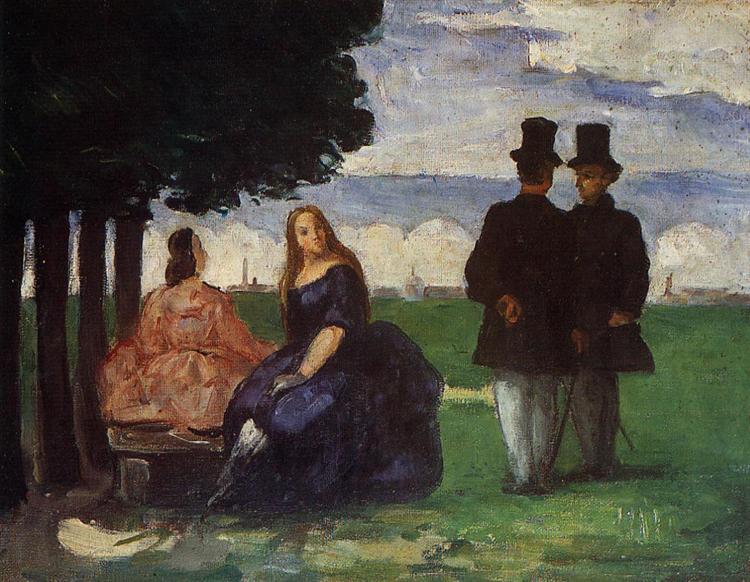תיאור
הציור "Paseo Marítimo" מאת פול סזאן, שבוצע בשנת 1866, הוא יצירה הרשומה בהקשר האניגמטי של המעבר בין ריאליזם לאימפרסיוניזם. ביצירה זו, סזאן מציעה לנו חזון מרתק העוטף הן את מהות חיי היומיום והן את ההפסקה הקרובה עם המוסכמות של האמנות האקדמית. במבט ראשון, הקומפוזיציה חושפת נוף בו הים והשמיים מתלכדים בדיאלוג עדין, בעוד זוג דמויות, אולי גבר ואישה, הולכים לאורך החוף, משולבים בסביבה טבעית זוהרת.
מבנה היצירה מסודר כך שהאופק - רצועה קלושה המפריד בין השמים לבין מימי כחול עמוק - הופך לבסיס לחקירת אור וצבע. סזאן משתמשת בפלטה עשירה שלמרות היותה כחולה וירוקה בעיקר, כוללת צהוב וטרקוטים המרמזים על השתקפות השמש על פני הים וחום החול. בחירה כרומטית זו אינה מקרית; זה מייצג צעד לעבר המודרניות בייצוג הנוף, שם האור הופך לגיבור כמעט חשוב כמו הדמויות עצמן.
הדמויות, הממוקמות בצד ימין של הקומפוזיציה, צבועות במשיכות שנראות מוצקות יותר בהשוואה לרקע האתרי. גיוון זה בטכניקת יישום הצבעים והקו מציע עומק שמזמין את הצופה להתבונן מעבר לייצוג פשוט. הדמויות אינן אידיאליזציה או שיש להן תכונות הבולטות בנפרד; הם ייצוגים של חיי היומיום המגלמים רגע חולף, רגע בו נראה מושעה. גישה זו רגילה, בשבריריות הרגע, היא תכונה ייחודית של עבודתו של סזאן ומהדהדת בחקירה השאפתנית של המרחב והצורה שלה.
השימוש בקו מדהים גם הוא, מכיוון שסזאן בונה רשת של קווים אופקיים ואלכסוניים המנחים את השקפת הצופה דרך היצירה, ויוצרת תחושת תנועה המשקפת את הבריזה הימית. תשומת לב מדוקדקת זו לקומפוזיציה הופכת למבשר לחידושים שיופיעו בהמשך באמנות מודרנית, שם אמנים מתחילים להטיל ספק במערכת היחסים בין האמיתי לייצוג.
"Paseo Marítimo" הוא, בעצם, עדות חזותית להתפתחותו של סזאן כאמן ומאבקו למצוא את שפתו שלו באמנות. בהקשר של המאה התשע -עשרה, סזאן התמודד עם נורמות אקדמיות קפדניות, ובכך, החל לסלול את הדרך לאסתטיקה חדשה שהדגישה את התפיסה האישית ואת פרשנות המציאות באמצעות פריזמה חדשה. יצירה זו משקפת רגע בו סזאן החל לאמץ את פיצול המרחב, שהפך לימים לאחד המאפיינים השולטים של סגנוןו.
יצירה זו לא רק חושפת את הכישרון המתעורר של סזאן, אלא גם מציעה חלון לעולם בו הוא עבר, שם אינטראקציה עם הנוף והחיפוש אחר אור וצבע היו נושאים בעלי חשיבות חיונית. הטכניקה, הצבע והאווירה של "טיילת" תורמים למקומם בתולדות האמנות, ומגבשת את פול סזאן כמגדלור בדרך למודרניות ומבשר למה שיבוא. היצירה בתהודה עם עקרונות שיישארו חיוניים לדורות של אמנים, מה שהופך אותה לאבן דרך בהתפתחות האמנות המערבית.
KUADROS ©, צבע מפורסם על הקיר שלך.
ציורי שמן בעבודת יד, עם איכות אמנים מקצועיים וחותם ייחודי של KUADROS ©.
שירות רבייה בתמונות עם ערבות שביעות רצון. אם אינך מרוצה לחלוטין מהעתק הציור שלך, אנו מחזירים את הכסף שלך 100%.

